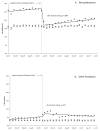Medicare part D's exclusion of benzodiazepines and fracture risk in nursing homes
- PMID: 20421554
- PMCID: PMC2907144
- DOI: 10.1001/archinternmed.2010.57
Medicare part D's exclusion of benzodiazepines and fracture risk in nursing homes
Abstract
Background: Medicare Part D excludes benzodiazepine medications from coverage, and some state Medicaid programs also limit coverage. We assessed whether such policies decrease the risk of fractures in elderly individuals living in nursing homes.
Methods: This is a quasi-experimental study with interrupted time-series estimation and extended Cox proportional hazards models comparing changes in outcomes before and after implementation of Medicare Part D in a nationwide sample of nursing home residents in 48 states. The study included 1 068 104 residents and a subsample of 50 874 residents with fracture data from 1 pharmacy. We assessed monthly prescribing rates of benzodiazepines and potential substitutes from January 1, 2005, through June 30, 2007, and hazard ratios for incident hip fracture and falls, adjusted for age, sex, and race/ethnicity. Estimates were stratified by concurrent Medicaid limits on benzodiazepines: no supplemental coverage (1 state), partial supplemental coverage (6 states), or complete supplemental coverage (41 states).
Results: The no-supplemental-coverage policy resulted in an immediate and significant reduction of 10 absolute points in benzodiazepine use (27.0% to 17.0%) after Medicare Part D was implemented (95% confidence interval, -0.11 to -0.09; P < .001). Benzodiazepine use remained stable in the partial-supplemental- and complete-supplemental-coverage states. Hazard ratios for incident hip fracture were 1.60 (95% confidence interval, 1.05 to 2.45; P = .03) in the no-supplemental-coverage state after Medicare Part D implementation and 1.17 (95% confidence interval, 0.93 to 1.46; P = .18) in the partial-supplemental-coverage states, relative to complete-supplemental-coverage states.
Conclusion: Supplemental drug coverage exclusion policies affect the medication use of nursing home residents and may not decrease their fracture risk.
Figures

 No supplemental coverage
No supplemental coverage  Partial supplemental coverage
Partial supplemental coverage  Complete supplemental coverage
Complete supplemental coverage
 No supplemental coverage
No supplemental coverage  Partial supplemental coverage
Partial supplemental coverage  Complete supplemental coverage
Complete supplemental coverage
Comment in
-
Benzodiazepine use in nursing homes: too much or too little?Arch Intern Med. 2010 Sep 27;170(17):1609; author reply 1609. doi: 10.1001/archinternmed.2010.328. Arch Intern Med. 2010. PMID: 20876418 No abstract available.
References
-
- Voyery P, Verreault R, Mengue PN, Laurin D, Rochette L, Martin LS. Managing disruptive behaviors with neuroleptics: treatment options for older adults in nursing homes. J Gerontol Nurs. 2005;31:49–59. quiz 60-1. - PubMed
-
- Granek E, Baker SP, Abbey H, et al. Medications and diagnoses in relation to falls in a long-term care facility. J Am Geriatr Soc. 1987;35:503–11. - PubMed
-
- Mustard CA, Mayer T. Case-control study of exposure to medication and the risk of injurious falls requiring hospitalization among nursing home residents. Am J Epidemiol. 1997;145:738–45. - PubMed
-
- Ray WA, Griffin MR, Downey W. Benzodiazepines of long and short elimination half-life and the risk of hip fracture. Jama. 1989;262:3303–7. - PubMed
Publication types
MeSH terms
Substances
Grants and funding
LinkOut - more resources
Full Text Sources
Medical

